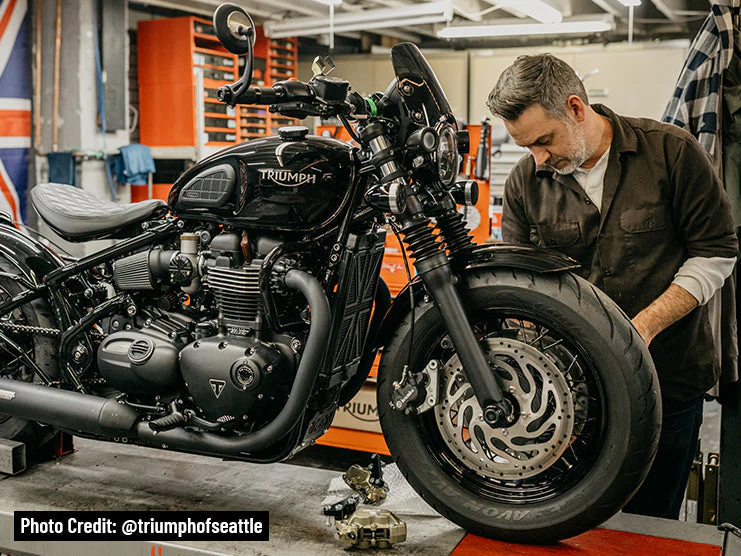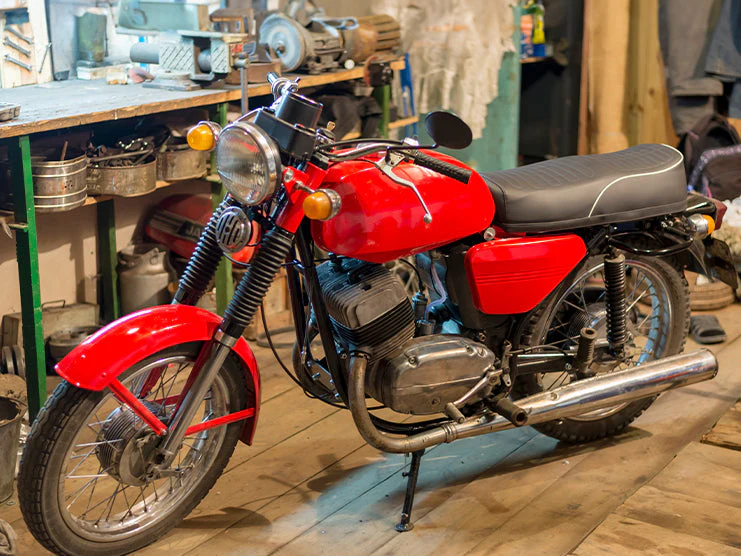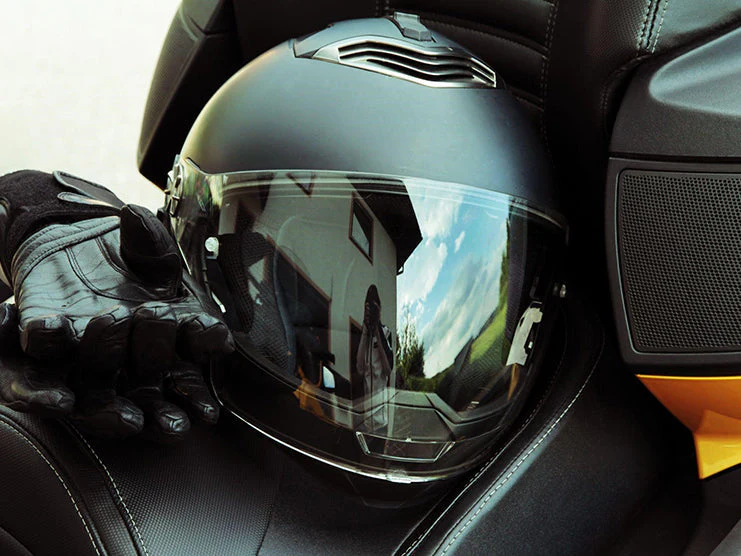Triumph motorcycles are an icon of reliability, style, comfort, and exceptional road performance. To ensure that your Triumph motorcycle continues to perform at its maximum efficiency in urban settings and on the highways, you must follow the recommended maintenance schedule. Regular maintenance ensures riding quality, extends lifespan, and guarantees a reasonable resale value. This article discusses the maintenance schedule, DIY safety checks, and average maintenance costs of Triumph motorcycles.
Table of Content
1. Triumph Motorcycle Maintenance Schedule
Triumph motorcycles usually have annual or 10,000-mile/16,000-km service intervals. Some maintenance tasks should be performed every day, while others should be done on a monthly or annual basis.
For your convenience, all maintenance tasks are categorized into regular checks and periodic services. The frequency of these tasks is mentioned in the chart below. Though there are only minor differences in the frequency of maintenance tasks between Triumph motorcycles, it is still recommended that you consult the owner’s manual along with the maintenance frequency chart below for model-specific information.
| Triumph Motorcycles Maintenance Schedule | |||||||
|---|---|---|---|---|---|---|---|
| Maintenance Tasks | Description | Maintenance Frequency Odometer Reading in Miles or Time Period (whichever comes first) |
|||||
| Every Day Checks | First Service | Annual Service | colspan="3">Mileage Based Service | ||||
| Engine & Lubrication | |||||||
|---|---|---|---|---|---|---|---|
| — | 500 mi/ 800 km | 1 Year | 10,000 & 30,000 mi/ 16,000 and 48,000 km | 20,000 mi/ 32,000 km |
40,000 mi/ 64,000 km | ||
| Engine | Check engine for leaks | ✔️ | ✔️ | ✔️ | ✔️ | ✔️ | ✔️ |
| Engine Oil | Change engine oil | ❌ | ✔️ | ✔️ | ✔️ | ✔️ | ✔️ |
| Engine Oil Filter | Change/renew engine oil filter | ❌ | ✔️ | ✔️ | ✔️ | ✔️ | ✔️ |
| Valve Clearance | Check valve clearance | ❌ | ❌ | ❌ | ❌ | ✔️ | ✔️ |
| Clutch Cable | Check and readjust clutch cable (if needed) | ✔️ | ✔️ | ✔️ | ✔️ | ✔️ | ✔️ |
| Engine Management & Fuel System | |||||||
|---|---|---|---|---|---|---|---|
| Throttle Body Plate | Check and clean the throttle body plate | ❌ | ❌ | ❌ | ✔️ | ✔️ | ✔️ |
| Throttle Bodies | Check balance | ❌ | ❌ | ❌ | ✔️ | ✔️ | ✔️ |
| Fuel System | Check the fuel system for leaks and chafes | ✔️ | ✔️ | ✔️ | ✔️ | ✔️ | ✔️ |
| Exhaust Clamp Bolts | Check and adjust exhaust clamp bolts | ❌ | ✔️ | ✔️ | ✔️ | ✔️ | ✔️ |
| Autoscan | Use a Triumph diagnostic tool. Make sure you get a printed customer copy of a full Autoscan. |
❌ | ✔️ | ✔️ | ✔️ | ✔️ | ✔️ |
| Air Cleaner | Change/Renew air cleaner | ❌ | ❌ | ❌ | ✔️ | ✔️ | ✔️ |
| Fuel Filter | Change/renew fuel filter | ❌ | ❌ | ❌ | ❌ | ✔️ | ✔️ |
| Fuel Hose | Change/renew fuel hoses | Change every four years regardless of low mileage or inactivity | |||||
| Evaporative Loss Hose | Change/renew evaporative loss hoses | Change every four years regardless of low mileage or inactivity | |||||
| Cooling System | |||||||
|---|---|---|---|---|---|---|---|
| Coolant Level | Check and adjust cooling levels | ✔️ | ✔️ | ✔️ | ✔️ | ✔️ | ✔️ |
| Coolant System | Thoroughly check cooling system for leaks | ❌ | ✔️ | ✔️ | ✔️ | ✔️ | ✔️ |
| Coolant | Change/renew coolant | Every three years regardless of low mileage or inactivity | |||||
| Ignition System | |||||||
|---|---|---|---|---|---|---|---|
| Spark Plugs | Check spark plugs | ❌ | ❌ | ❌ | ✔️ | ❌ | ❌ |
| Steering & Suspension | |||||||
|---|---|---|---|---|---|---|---|
| Forks | Check for leaks to ensure smooth operation | ✔️ | ✔️ | ✔️ | ✔️ | ✔️ | ✔️ |
| Fork Oil | Change fork oil | ❌ | ❌ | ❌ | ❌ | ❌ | ✔️ |
| Headstock Bearings | Check and adjust headstock bearings | ❌ | ✔️ | ✔️ | ✔️ | ✔️ | ✔️ |
| Lubricate headstock bearings | ❌ | ❌ | ❌ | ❌ | ✔️ | ✔️ | |
| Steering | Check for free steering operation | ✔️ | ✔️ | ✔️ | ✔️ | ✔️ | ✔️ |
| Braking System | |||||||
|---|---|---|---|---|---|---|---|
| Brake Pads | Check wear levels | ✔️ | ✔️ | ✔️ | ✔️ | ✔️ | ✔️ |
| Brake Fluid | Check fluid levels | ✔️ | ✔️ | ✔️ | ✔️ | ✔️ | ✔️ |
| Change/renew fluid | Every two years regardless of low mileage or inactivity | ||||||
| Brake Master Cylinders | Check for fluid levels | ❌ | ✔️ | ✔️ | ✔️ | ✔️ | ✔️ |
| Brake Calipers | Check for seized pistons and fluid leaks | ❌ | ✔️ | ✔️ | ✔️ | ✔️ | ✔️ |
| Anti-lock Braking System (ABS) and ECMs | Check for stored DCTs | ❌ | ✔️ | ✔️ | ✔️ | ✔️ | ✔️ |
| Wheels & Tires | |||||||
|---|---|---|---|---|---|---|---|
| Tire Pressure | Check and adjust tire pressure | ✔️ | ✔️ | ✔️ | ✔️ | ✔️ | ✔️ |
| Tire Wear/Damage | Check tread depth and damage patterns | ✔️ | ✔️ | ✔️ | ✔️ | ✔️ | ✔️ |
| Wheels | Inspect for damage | ✔️ | ✔️ | ✔️ | ✔️ | ✔️ | ✔️ |
| Wheel Spokes (if present) | Check spoke tightness and inspect for spoke damage | ✔️ | ✔️ | ✔️ | ✔️ | ✔️ | ✔️ |
| Wheel Bearings | Check for wear to ensure safe and smooth operation | ❌ | ✔️ | ✔️ | ✔️ | ✔️ | ✔️ |
| Electrical | |||||||
|---|---|---|---|---|---|---|---|
| Electrical Systems, Lights, Instruments | Check functionality | ✔️ | ✔️ | ✔️ | ✔️ | ✔️ | ✔️ |
| Drive Chain | |||||||
|---|---|---|---|---|---|---|---|
| Drive Chain | Check and adjust chain slack | ✔️ | ✔️ | ✔️ | ✔️ | ✔️ | ✔️ |
| Check rubbing strip | ❌ | ✔️ | ✔️ | ✔️ | ✔️ | ✔️ | |
| Check for wear/damage | Every 500 miles | ||||||
| Lubricate drive chain | Every 200 miles | ||||||
| General | |||||||
|---|---|---|---|---|---|---|---|
| Side Stand | Lubricate side stand and check operation | ✔️ | ✔️ | ✔️ | ✔️ | ✔️ | ✔️ |
| Fasteners, Nuts, & Bolts | Tighten if needed; inspect visually for damage | ✔️ | ✔️ | ✔️ | ✔️ | ✔️ | ✔️ |
| Bank Angle Indicators | Inspect carefully for wear | ✔️ | ✔️ | ✔️ | ✔️ | ✔️ | ✔️ |
1.1 Triumph Motorcycle Maintenance Recommendations
It is recommended that you take your motorcycle to an authorized Triumph motorcycle dealer for the following quality maintenance:
- Annual maintenance
- Mileage-based maintenance
- Combination of both, depending on the number of miles covered or inactivity of the motorcycle in a year
Here are tips to help you follow the maintenance schedule and manage all the tasks properly:
- Motorcycles that travel less than 10,000 miles/16,000 km each year must be maintained annually. Moreover, mileage-based maintenance tasks must be performed at their specific intervals after the motorcycle reaches the mileage threshold.
- Motorcycles that travel exactly 10,000 miles/16,000 km each year must have annual and mileage-based maintenance conducted together.
- Motorcycles that travel more than 10,000 miles/16,000 km each year must have mileage-based maintenance conducted as soon as the motorcycle reaches the mileage threshold. Moreover, annual maintenance tasks must be performed at specific annual intervals.
- For optimal performance and safety, make sure that maintenance tasks are performed at or before the specified maintenance intervals. Consult the authorized dealer for advice on the best maintenance schedule for your bike.
- You might not be able to take advantage of the warranty due to incorrect maintenance and adjustment.
1.2 DIY Triumph Motorcycle Maintenance
Daily checks are pre-ride safety checks a rider should perform every day before taking their bike out for a ride. You can easily perform these checks on your own without having to take your bike to a mechanic. However, some of these tasks may require specific tools, so make sure you do thorough research and learn how to perform these tasks correctly.
Tire Condition
Make sure that the tires have adequate tread depth, and no irregular patterns, cracks, or bulges. You can use a tread depth gauge to check the tire tread depth. Insert the gauge probe into the tire's grooves and push until it touches the groove base. Record the reading and check if it matches the recommended tire tread depth. The minimum required tread depth for motorcycle tires is 1.5-1.6 mm; however, for safety reasons, it is recommended that tires be replaced after the tread depth is worn down by 3-4 mm.
Tire Pressure
Check the tire pressure using a pressure gauge. Properly inflated tires ensure optimal traction, handling, and grip. Check tire pressure every week if you don’t ride your bike regularly. Consult your owner’s manual to check the recommended tire pressure. You can also find the sticker listing the recommended tire pressure on the swingarm, frame, or under the seat. Then unscrew the valve cap from the valve stem and press the tire pressure gauge firmly into the valve stem. The gauge will show the current tire pressure, indicating whether it is at or below the recommended tire pressure. If the tire pressure is low, add air until it is at the correct pressure. If it is too high, release the excess air. To adjust pressure, use an air pump. If you don’t have one, take your bike to the nearest flat tire repair service.
Chain Tension
The drive chain ensures smooth power transmission and protects other components connected to the drive chain from becoming damaged. Consult the owner’s manual and an authorized Triumph dealership to learn how to adjust chain tension correctly. For any Triumph model, it is best to adjust the tension while a rider is seated on the motorcycle to ensure the chain is tightened correctly. Make sure you lubricate and clean the chain regularly to avoid rust build-up.
Battery
Inspect the battery at least once per week, if not daily. Remove the battery from the motorcycle to check the acid level. Because Triumph batteries are sealed, you may need to take yours to an authorized dealership to inspect the acid level. Grease the battery terminals before re-installing the battery back onto the motorcycle. This will prevent corrosion that may occur over time due to exposure to moisture. Avoid touching both terminals simultaneously and follow the battery care guidelines in the owner’s manual.
Oil Level
Triumph motorcycles are equipped with a “sight glass” that allows you to check the oil level. This sight glass is positioned near the Triumph brand engine cover. Look through the sight glass weekly. If the oil level is below the minimum mark on the sight glass, fill it with the recommended amount of oil to avoid engine damage. Do not neglect to check your bike’s oil level due to low mileage or inactivity.
Apply Grease
Applying grease to moving parts can increase their lifespans and reduce wear and tear. Use a grease spray to lubricate the hinges, levers, footpegs, locks, and other Triumph parts mentioned in the owner’s manual. Do not apply grease to the brake discs since it will reduce braking power.
Brakes
Check the brake pads for wear and tear, the responsiveness of the brake lever, and any brake fluid leaks.
Fluid Levels
Check the engine oil, coolant, and clutch fluid levels. Low fluid levels may indicate leaks or other problems. If there is no visible damage, it is best to take your motorcycle to a qualified technician for a proper diagnosis.
Lighting
Make sure all the lights are functioning properly, including the headlight, tail light, brake light, turn signals, and high beam.
2. Advantages of Getting Maintenance at Triumph Dealerships
With over 160 authorized Triumph motorcycle dealerships in the United States, these establishments are ideal for motorcycle maintenance. Listed below are reasons why your bike should get maintenance at Triumph dealerships:
- Your Triumph motorcycle gets serviced by fully-trained technicians. In addition, they provide reliable customer support and excellent motorcycle care.
- Triumph technicians are trained at Triumph Academy, offering training programs meant to teach technicians the necessary skills to fix old and new models.
- Expert advice is readily available about preventive maintenance, large-scale repairs, and replacements.
- There are no surprise bills at Triumph dealerships. You can request a price quote/estimate for the maintenance bill.
- Motorcycle software is updated regularly.
- Original parts are readily available.
- Specialized tools and equipment are used to provide quality service and workmanship.
3. Are Triumph Motorcycles Expensive to Maintain?
Not exactly. Whether Triumph motorcycles are expensive to maintain depends on your riding style, frequency of use, and how well it is maintained. Generally, Triumph motorcycle maintenance is less expensive compared to other motorcycles. But if you take replacements and large-scale repairs into consideration, then maintenance costs will increase significantly like with any other motorcycle. It is also worth mentioning that some Triumph motorcycles are equipped with high-tech features, anti-lock braking systems, and automatic transmission systems. To maintain these Triumph models, specific diagnostic tools and certified technicians are required, resulting in higher maintenance costs.
4. Average Maintenance Cost of Triumph Motorcycles
The average maintenance cost of Triumph motorcycles is determined by factors like model, use, location, and age of the motorcycle. Other factors that influence maintenance costs are:
Timely Routine Maintenance
Regular maintenance tasks such as fluid refills and changes, tire replacements, chain adjustments, brake maintenance, brake pad replacements, oil changes, and air filter replacements are standard for motorcycles of all brands. These routine tasks may cost between $200-$600.
Original vs Aftermarket Parts Replacements
Original Triumph parts are more expensive than aftermarket parts. However, original parts are more reliable and can save you a lot of money in the long run, unlike aftermarket parts that are cheap and prone to damage.
Triumph Model
Older Triumph models require more frequent repairs, increasing average annual maintenance costs.
Authorized Triumph Dealerships
Choosing an authorized Triumph dealership over local mechanics can slightly increase maintenance costs, but this will also ensure quality service.
Warranty
Keeping up with maintenance ensures your warranty stays valid. Warranties and service plans can cover many maintenance tasks while it is still active.
Inflation
Rising inflation can increase the costs of servicing, engine oil, automotive fluids, and replacement parts, contributing to higher maintenance costs every year. The average costs can range between $500-$3,000 or more depending on your bike’s condition and the other factors mentioned above.
5. Takeaway
Following the maintenance guidelines in your Triumph motorcycle’s owner’s manual can help keep your ride in peak condition. Maintenance schedules are intended to ensure the rider’s safety and the motorcycle’s longevity. Consider all maintenance work as an investment rather than a chore. All maintenance work will help preserve your Triumph motorcycle’s performance and resale value. If you find it difficult to remember upcoming maintenance tasks, then use motorcycle maintenance apps, digital calendars, and notes to organize records and keep track of upcoming maintenance tasks, replacements, and costs.













Leave a comment
All comments are moderated before being published.
This site is protected by hCaptcha and the hCaptcha Privacy Policy and Terms of Service apply.